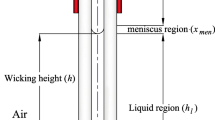Summary
This work is concerned with evaporation from a meniscus (an air-liquid interface) on the end of a small bore, vertically oriented capillary tube. The equations governing the dynamics of the meniscus are derived by considering an evaporation-driven fluid flow. They lead to a nonlinear differential-integral equation which is linearized for small meniscus motions about steady state equilibrium.
The linearized equation is shown to contain a single dimensionless parameterK. The motion resulting from a step increase in evaporation rate is shown to be monotone forK<K 0∼47, while forK>K 0a damped oscillatory motion results. A closed form approximate solution is presented, valid for smallK.
This work was motivated by the study of transpiration in plants.
Zusammenfassung
Diese Arbeit beschäftigt sich mit dem Verdunsten eines Meniskus (Trennfläche Luft-Flüssigkeit) am Ende einer engen, vertikal gerichteten Kapillarröhre. Die Gleichungen, die die Dynamik des Meniskus beschreiben, werden durch Betrachtung der durch die Verdunstung hervorgerufenen Flüssigkeitsströmung abgeleitet. Diese führen zu einer nichtlinearen Differential-Integral-Gleichung, die für kleine Meniskusbewegungen um eine stationäre Lage linearisiert wird.
Die linearisierte Gleichung enthält einen einzigen dimensionslosen ParameterK. Die Bewegung hervorgerufen durch eine schrittweise Zunahme der Verdunstungsgeschwindigkeit ist monoton fürK<K 0∼47, wogegen fürK>K 0eine gedämpfte Schwingung auftritt. Für kleineK wird eine geschlossene Näherungslüsung angegeben.
Die vorliegende Arbeit wurde durch die Untersuchung der Verdunstung in Pflanzen angeregt.
Similar content being viewed by others
References
Landau, L. D., Lifshitz, E. M.: Fluid Mechanics. Pergamon. 1959.
Adamson, A. W.: Physical Chemistry of Surfaces, pp. 13, 278. Interscience. 1960.
Nobel, P. S.: Introduction to Biophysical Plant Physiology. Freeman. 1974.
Wayner, P. C.: The Effect of Viscous Shear on a Meniscus in an Electrochemical System. J. Electrochem. Soc.119, 584–588 (1972).
Merva, G. E.: Physioengineering Principles. Avi Pub. Co., Westport, Conn., 1975.
Jarvis, P. G., Slatyer, R. O.: The Role of the Mesophyll Cell Wall in Leaf Transpiration. Planta (Berl.)90, 303–322 (1970).
Levich, V. G.: Physicochemical Hydrodynamics, pp. 382–383. Prentice-Hall. 1962.
Cooke, J. R., De Baerdemaeker, J. G., Rand, R. H., Mang, H. A.: A Finite Element Shell Analysis of Guard Cell Deformations. Trans. ASAE.19, 1107–1121 (1976).
James, G., James, R. C.: Mathematics Dictionary, p. 347. Van Nostrand. 1959.
Hochstadt, H.: Special Functions of Mathematical Physics. Holt, Rinehart and Winston. 1961.
Hildebrand, F. B.: Methods of Applied Mathematics, 2nd ed., p. 274. Prentice-Hall. 1965.
Scott, E. J.: Laplace Transformation, Chapter 19 in: Handbook of Engineering Mechanics (Flugge, W., ed.). McGraw-Hill. 1962.
Author information
Authors and Affiliations
Additional information
With 1 Figure
Rights and permissions
About this article
Cite this article
Rand, R.H. The dynamics of an evaporating meniseus. Acta Mechanica 29, 135–146 (1978). https://doi.org/10.1007/BF01176632
Received:
Issue Date:
DOI: https://doi.org/10.1007/BF01176632




